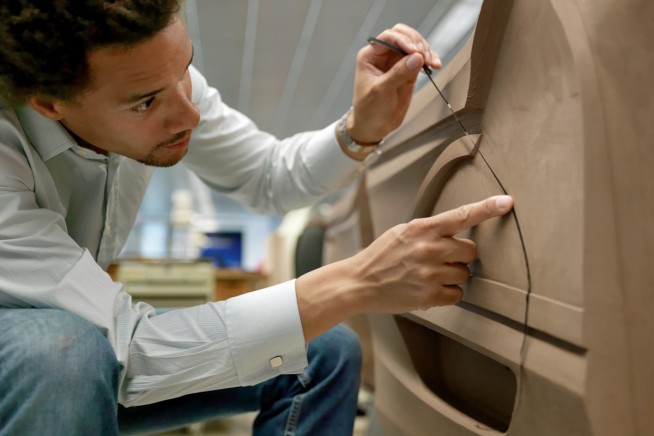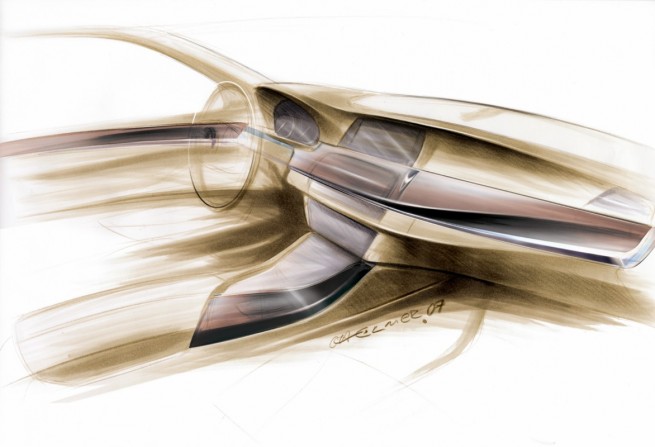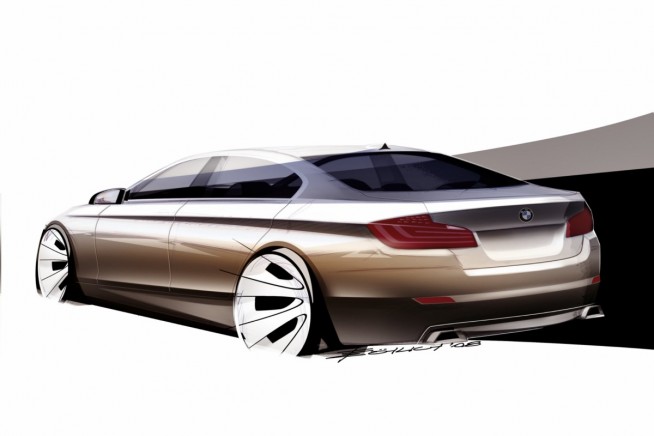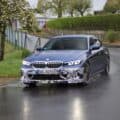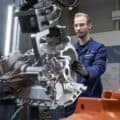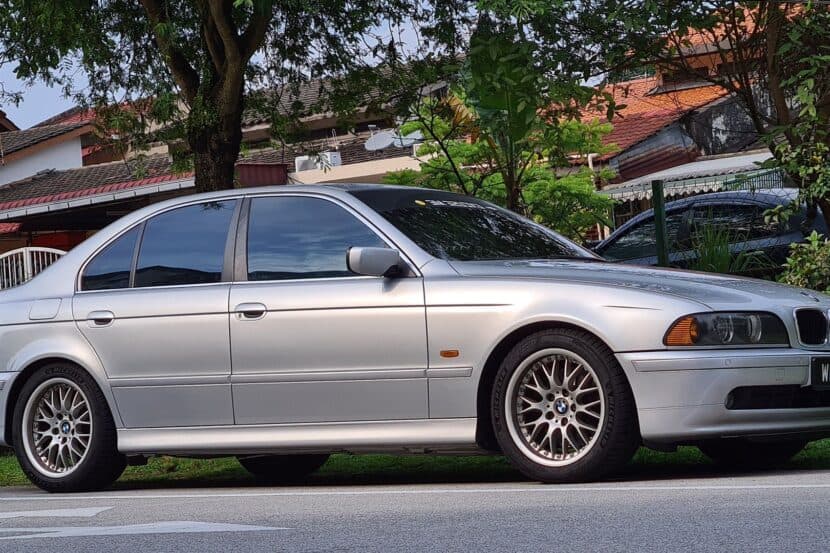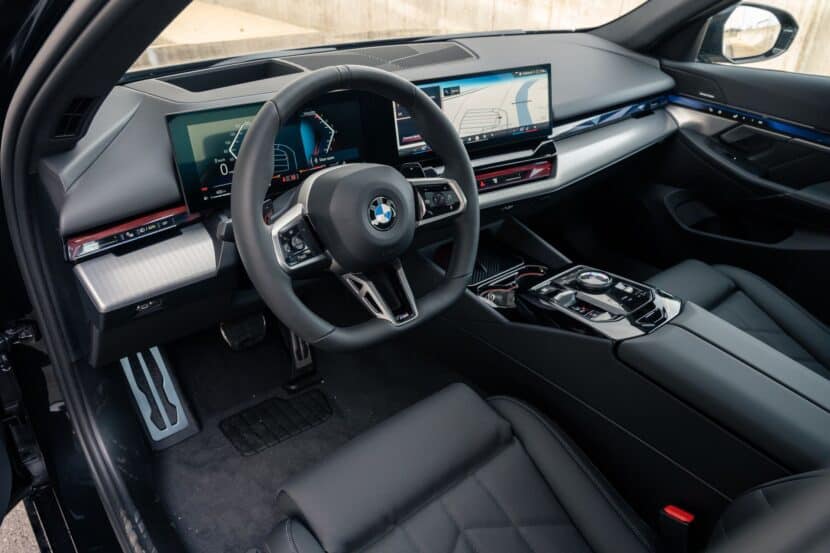En Route to Perfect Aesthetics. The Process of Design in the BMW Group, Focusing on the New BMW 5 Series Sedan as an Example.
The new BMW 5 Series Sedan combines the elementary values and fortes of the BMW brand in a highly concentrated form. This is where supreme aesthetics and superior dynamics come together with exemplary efficiency, outstanding comfort and uncompromising premium quality.
Indeed, the n ew Sedan not only combines all these features in truly convincing style, but also offers unmistakable character ensured by smooth interaction of design, driving characteristics and function all working in perfect harmony.
The ideal combination of all the car’s features and characteristics is the result of a unique process of product creation – a process borne out by the skills and abilities of the contributing specialists in the areas of design, technology and craftsmanship. To capitalise on the creative potentials of these specialists in the widest conceivable range of development activities, the BMW Group has created appropriate organisational, technical and architectural conditions enabling the various contributors to create and develop the optimum solution. This ensures that all kinds of tasks and processes in development may be handled individually but parallel to one another. At the same time permanent harmonisation of the progress made by the individual departments ensures that the overall result achieved at the end of the day is perfectly balanced and fully coordinated.
Convergence of design and technology: the perfect synthesis of form and function. Continuous, ongoing progress comes from specialisation, creativity is born out of dialogue. This principle is reflected both in the organisational and spatial conditions established by the BMW Group for the development of a new model.
The BMW Group has implemented a particularly target-oriented form of project management, with specialists from all areas and departments delegated into a Joint Project Team for the duration of the development process for a new model. This concept brings together superior competence from all departments and divisions involved, meaning not just Design, Drivetrain and Suspension Technology, Electrics and Electronics as well as Safety, but also Materials Research, Production, Purchasing, Logistics, Controlling, Marketing and Human Resources.
A permanent, ongoing dialogue within the Project Team provides the opportunity to recognise conflicts of interest in design, construction and production technology from an early point in the process of product creation and to solve such potential problems right from the start. This creates smooth convergence of design and technology seeking to achieve an ideal synthesis of form and function – a synthesis considering all factors crucial to design, the construction and finish of surfaces, function, and the effects of various components.
Progress achieved in individual areas is conveyed to other areas through direct feedback with the respective specialists, permanent exchange within the Project Group guarantees a harmonious balance of all features within an interacting overall concept. This ensures comprehensive utilisation of the competences available in each area of technology and makes the clearly defined character of the new model the joint benchmark for the ongoing development process.
The melting pot for creativity: the BMW Project Building.
The special layout and structure of the BMW Group’s Research and Innovation Centre (German abbreviation: FIZ) in Munich effectively promotes the ideal balance of specialisation and dialogue. Particularly the architectural concept of the Project Building right in the middle of the FIZ Centre clearly renders the fundamental principle of product creation, offering perfect conditions for simultaneous engineering, the development and creation of new solutions in parallel by various teams and departments, and the ongoing dialogue of the experts delegated to the Project Team.
The contributing specialists may be concentrated within the Project Building for the entire duration of the respective project, promoting the development of the new vehicle by way of a reference model binding to all areas and departments and using the most advanced virtual tools in the process.
The FIZ Project Building started operation five years ago, and the new BMW 5 Series Sedan is one of the first cars benefiting in full in the process of product creation from the potentials of the Project Building.
The Project Building is split up into a Central Area with four double floors and the Ring Building covering five floors, offering a gross area of more than 90,000 square metres or 968,000 square feet. The workplaces for specialists from all areas and departments are laid out around an Inner Court with the glazed Central Building in the middle. The current state of development of the respective model is presented on the four levels of this Central Building both virtually and by various scale models and renderings.
Short distances, flexible use of space available, superior efficiency.
Benefiting from this specific layout, the specialists in individual areas are able to check out the latest status of development at any time right “next door” to their own workplace. Clearly, this means very efficient and target- oriented procedures in practice. The architecture of the building and the entire area promotes the process of communication and consistently brings together those specialists able to nurture each other with new input for the ongoing development process. The latest achievements in development may be coordinated immediately with other members of the Project Team, and knowledge gained from such a direct exchange may be fed back straight to the responsible functions and departments.
The architectural concept as a whole follows the results of scientific studies on the course of creative processes. According to a long-term study by the Massachusetts Institute of Technology (MIT), 80 per cent of all innovative concepts and ideas result from personal communication. Precisely this is why the Project Building offers exactly the right layout and spatial configuration for an active dialogue, motivating the specialists to work together and facilitating the exchange of knowledge.
Several BMW, MINI and Rolls-Royce models are consistently developed in the Project Building in a permanent, ongoing process. Hence, the architecture of the Building alone ensures particularly flexible and efficient use of the space available, the four double floors of the Central Building forming individual blocks with a useful area in each case of 1,500 square metres or 16,000 square feet. The interior layout and features of the workplaces likewise follow the standards of the BMW Group, with the offices, workshops and studios offering a clear and sophisticated ambience dedicated to timeless style and unique design.
Centralised acquisition of data and networking for efficient dialogue. Like the architecture of the Project Building, modern data processing also serves to ensure efficient and target-oriented communication during the process of product creation. High-performance web technology enhances the network of the departments and function areas involved in each project, with all relevant project data being available online at any time, up to the latest status. Simultaneous availability and central administration of such data serves to promote quality assurance and efficiency throughout the entire project.
Simultaneous engineering offering the opportunity to permanently harmonise the latest developments and findings creates ideal conditions for handling even the most complex and challenging tasks. The architectural and organisational conditions offered by the Project Building enable the contributing specialists to duly consider a growing number of functions, components and systems in the development of a modern automobile very quickly and with utmost precision.
From the original idea through the first draft to the final model.
The process of creating a new model covers a period of several years, starting with the determination of the vehicle’s concept and the formation of the Project Team. From then on all departments and functions work together closely in achieving the targets defined for the respective model, focusing consistently on all technical components and the design of the vehicle which, in accordance with the design philosophy of the BMW Group, must render the specific values of the product and its substance accurately and authentically in and through aesthetically convincing design language.
The fundamental features of the Package Plan are determined right from the start at the beginning of the project phase, generally some five years prior to the planned start of production of the new model. At the same time the designers create the first scale models and renderings of the new vehicle.
Such determination of the vehicle’s proportions is of great significance within the design process. Like every product, an automobile must have ideal proportions as the key to aesthetic design and harmonious looks. And since the human being has a well-honed and very natural feeling for proportions, precisely this feeling is crucial to the first impression he gets of a new car.
With this in mind, well-balanced proportions were given particularly high priority in the process of designing the new BMW 5 Series Sedan. The coupé-like, smoothly flowing roofline, the long wheelbase, the short overhang at the front and the long engine lid give the car an elegant and at the same time an unusually dynamic look. Enhanced by the powerful shoulders and the wide rear end, these proportions clearly and authentically confirm the superior, sporting character of the BMW 5 Series Sedan.
The design process is split up into three phases to be completed by each vehicle during its development in BMW Group Design. Within the Company, these design phases are referred to as Understanding, Believing, and Seeing.
The first phase seeks to create a joint understanding of all contributing factors and their impact on the design proposed, essential features of the Package.
Plan such as the wheelbase, luggage compartment capacity, the range of engines, interior width and safety requirements are already known at this point as the original parameters and general input for the design process. Hence, the convergence of design and technology requires superior integration and networking right from the start even at this point. After all, all the technical innovations available are to be implemented in an appropriate manner perceived later by the user as perfect in their functions, as meaningful and, at the same time, beautiful to behold.
Internal contest as the starting point in designing the new BMW 5 Series Sedan. An internal contest in designing the exterior and interior is one of the most important highlights in the process of BMW Group Design. The designers compete with one another in a highly creative contest, finally presenting their personal drafts and designs. Under the guidance of the responsible Head of BMW Group Design, the entire Exterior and Interior Design Team develops all kinds of different ideas from the start in the process of designing the new BMW 5 Series Sedan, using sketches, virtual renderings, and clay models.
Proceeding from the proportions of the new vehicle already determined in advance, the task in the next phase is to create the characteristic design language of the respective vehicle. Input comes in this case from innovative design drafts and the objective to offer a supreme aesthetic balance of proportions and surfaces.
In developing the new BMW 5 Series Sedan, the designers and model builders worked together in this phase to create 1:1 models following precisely these criteria. Indeed, only very few car makers attach such great attention to 1:1 models made of clay as a special material used by the designer and refined to even the smallest detail.
Covered by a special surface film very similar to body paintwork in Titanium Silver Metallic, each clay model enables the beholder to realistically judge its lines, surfaces and proportions under all kinds of light conditions.
A further advantage is that clay models provide the option to consistently enhance and develop the original design draft, each modification being implemented directly on the 1:1 model and thus made visible quickly and realistically.
The number of clay models is reduced step-by-step in the Believing phase through decisions taken by the Board. During this phase the designers form a firm conviction of the perfect exterior and interior of the new model,
the way they see the ideal result. The final decision on the design to be implemented is taken some three years prior to the start of production in a final round of scrutiny comparing the last two variants.
In the ensuing Seeing phase of design development, both the exterior and interior design are presented in all their details, with careful refinements down to the smallest points. Here again, all demands and requirements are coordinated with utmost care through close interaction with the other departments in the process of design and technology convergence.
Further coordination down to hundredths of a millimetre is ensured through the constant exchange of designers, engineers and production specialists, again seeking to give the final product a supreme premium standard from the quality of its surface all the way to each micro-feature. Extreme precision is of utmost significance in this phase, since even the slightest inaccuracy would subsequently be rendered and multiplied hundreds of thousands of times on the actual production model.
Only when all this has been done is the sculpture perfected by human skill translated into a product reproducible by machines. The design model is converted through CAD using laser scanning into a three-dimensional feasibility model providing the technical reference point for all further developments.
Perfect harmony of craftsmanship and virtual development.
The design chosen is implemented in the process of series development by careful interaction of computer-based renderings and presentations and equally painstaking work on the clay model. This again reflects the philosophy of BMW Group Design, seeing the human being as the central factor in creating emotionally powerful design. Virtual methods are applied in parallel to optimise both the efficiency of the development process and the precision of design and construction assurance.
Rapid prototyping is a further option in creating the fundamental parameters required for a meaningful decision-making process. Proceeding from the data defined by the computer, design specialists are able to build three-dimensional models of individual components, enabling them to assess the dimensions, ergonomics or geometry of the vehicle at an early point.
The combination of skilled craftsmanship and virtual development is further refined by years of experience in each development project, making ever-greater use of the respective methods and their potentials.
The Powerbench: three-dimensional presentation in supreme quality. The FIZ Project Building uses the most advanced simulation systems for developing a new vehicle with supreme efficiency, precision, and versatility. Individual components and even complete vehicles are therefore “built” in virtual reality (VR). Long before the first prototype of a new model sees the light of day, VR technology gives designers the option to visualise their draft in a truly complete and comprehensive process, even presenting individual variants and using all kinds of background scenarios.
The heart of these simulation systems is the Powerbench presenting both future vehicles and individual components in their original size in both two and three dimensions. On this reverse projection wall measuring 6 metres or almost 20 feet in width and 2.7 metres or nearly 9 feet in height, four projectors create an image with four times the usual standard of high definition (4,096 x 2,160 pixels), each pixel measuring 1.5 millimetres or 0.06” in size. This brings out even the finest details such as the curvature of the kidney bars on the front end of the new BMW 5 Series Sedan or the seam pattern of each seat, again offering the highest standard of reality.
The projectors are fed by 23 high-performance PCs with high-end graphic cards installed in the same area to ensure maximum image quality through short cable connections. Each projector is made up of four elements controlled by an individual PC, with a central computer coordinating the overall transfer of data.
Three-dimensional presentation is provided by the addition of a floor projection unit measuring approximately 6 x 2.4 metres (19.7 x 7.9 feet). The observer looks at the images created through special glasses providing a three-dimensional impression, the position of the beholder within the projection area being monitored by a combination of eight cameras and taken into account in presenting the final image. With each change of this angle of vision, the beholder receives a new perspective of the model presented – he is able to check out the virtual vehicle from various distances and even walk around the car.
Precise analysis for perfect surface quality.
This superior technology enables the designer, the body specialist and the constructor to analyse, say, the effects of various surfaces and body joints on the basis of a virtual model, comparing individual variants under identical light conditions. This also allows a comparative analysis of different colour variants on the body or within the interior very quickly and efficiently, offering a range of choice and different perspectives hardly achievable with real-life models (or only with a great effort).
The Powerbench is now used in all product creation processes as a vital tool for the simulation of models. To present the new BMW 5 Series Sedan from all perspectives and in all its features on the Powerbench, the 3D model is made up of 12 million triangles or polygons and may even be moved in real time.
The options provided by the Powerbench enhance the assurance of surface quality particularly significant in BMW Group Design. This is because the extremely refined presentation technology used in this case also renders reflection lines showing light and shade from all different angles, again in full detail and very realistically.
The harmonious flow of surfaces with exciting, elaborately chiselled and consistently attractive curvature and contours from every angle may therefore be rendered and assured from the start on the virtual vehicle. The BMW 5 Series Sedan, for example, comes with particularly smooth transitions from the engine lid to the front side panels perfected, together with other technologies, through the refined work and processes conducted on the Powerbench.
The radius on the upper surround of the BMW kidney is another example of precision work on a virtual model. The reflection lines shown in the Powerbench serve to simulate incoming light and the image perceived by the beholder from various perspectives. Using this preview function, the designers were in a position to carefully optimise the contours of the kidney surround, modelling the surfaces on the Powerbench with utmost refinement to achieve an extremely dynamic flow of reflection lines. On the “real” car this gives the front end an even more subtle and very refined, sporting look.
In the convergence of design and technology, the Powerbench also serves to ensure the most perfect conceivable synthesis of form and function. In designing the new BMW 5 Series Sedan it was essential, for example, to meet greater demands in terms of pedestrian safety involving repercussions, among other things, on the height of the engine compartment lid. The ideal contours of the lid from the perspective of safety were first set out by way of defined points. Then the graphic compiled in this way was compared on the Powerbench with the shapes and lines favoured by the designers, presenting the freedom in design possible as well as any conflicts of interest. This made it possible from an early point in designing the new
BMW 5 Series Sedan to find a convincing balance of striking front end design, on the one hand, and pedestrian safety, on the other. The “Hofmeister kink”: a challenge in design, construction and production. The design of the side window graphics around the C-pillar is one of the typical signs of distinction of every BMW – and precisely here the new BMW 5 Series Sedan comes with a strikingly elegant, sleekly stretched side window giving the entire passenger cell a particularly light and low-slung look and dynamically highlighting the silhouette of the Sedan.
To generate this effect the rear side window was wrapped around far into the C-pillar, giving it a very slender appearance. The counter-swing on the window surround well-known as the “Hofmeister kink” therefore comes in an unusually tight radius.
Presentation of this design feature on the Powerbench again confirms the precise balance of design, construction and production in the convergence of design and technology. To give the “Hofmeister kink” the very tight radius desired, the demands made in production are particularly challenging and require innovative solutions in terms of the materials used and the production technology applied.
Coordinating these requirements at an early point, the Project Team was able also in this case to use and further develop specialised know-how in finding a perfect synthesis of form and function.
Cubing: highly realistic models assuring the looks of the vehicle beyond its visual impression. While the potentials of virtual presentation are constantly increasing, the final assurance of a vehicle and its individual components will only be possible even in future with the help of real-life models. Only such models offer an overall view and impression of the design enhanced on the Powerbench going beyond the purely optical rendering.
Proceeding from CAD data saved in the central computer, the BMW Group therefore builds and analyses “solid” models in their original size in a process referred to as “cubing”. The solid model is made of uriol, a special synthetic material, and rests on a flexible frame with adjustable fastening points allowing quick and low-cost configuration of the respective model. Cubing provides a partial rendering of the exterior and interior as well as a complete and true-to-original model of the entire vehicle, the only difference being that this model is not yet ready to drive.
The cubing process applied by the BMW Group serves to present the exterior and interior design of a car in its original size as one common unit. Splitting the model longitudinally, cubing also allows a comparative analysis of several colour or equipment variants directly next to one another. This provides a broader base for choosing the design of many components, since the features of the solid model are perceived not only optically. As an example, the ergonomic impression of shift levers varying in size as well as the degree of comfort in entering the car cannot be verified sufficiently by virtual presentation alone. Similarly, factors such as the occupants’ seating position or the exact arrangement of the controls and switches can only be judged once and for all by means of a true-to-life solid model. In the process of product creation, the interaction of virtual presentation and visualisation is consistently refined by cubing. An example of optimised design made possible both by the Powerbench and on the three-dimensional model is the transition from the instrument panel to the door linings inside the new BMW 5 Series Sedan. The horizontally aligned structure and the stretched lines of the instrument panel flow through the door linings all the way back to the rear, the occupants thus experiencing the entire interior as one harmonious entity.
To optimise this feeling of space, the challenge was to integrate the joint between the instrument panel and the door lining indispensable for functional reasons into the harmonious overall look of the interior. This is ensured by trim bars with an accentuating function positioned both in the instrument panel and in the door linings on the same level beneath the respective trim surfaces. At the transition point between the instrument panel and the door lining these accentuating bars meeting one another in an upward swing to form an exciting eye-catcher, highlighting the flow and function of the joint but reducing the optical impression of its width.
The new BMW 5 Series Sedan: authentic character, supreme flair.
All features and the well-balanced overall impression of the new BMW 5 Series Sedan are the result of a unique process of product creation. This renders not only the uncompromising premium claim of a BMW Group product, but also the unmistakable style of the BMW brand as well as the precisely defined character of this particular model. Both in its design and functional features, the new BMW 5 Series Sedan represents the broad competence of the BMW Group in developing a modern sedan in the upper midrange segment. The process of product creation is characterised by genuine passion for aesthetic design and dynamic performance, precision and perfection,
as well as – going even further – the ability to use all methods and media to their full potential. The result is vehicles proudly boasting that truly unmistakable and authentic character so typical of the brand. Precisely this is why the complete harmony of functional features and the effect generated by the design of the car comes out so clearly also on the new BMW Sedan.
The latest rendition of the modern Executive Express emanates truly characteristic flair and supreme style as a major element in creating fascinating appeal and irresistible desirability all in one.




